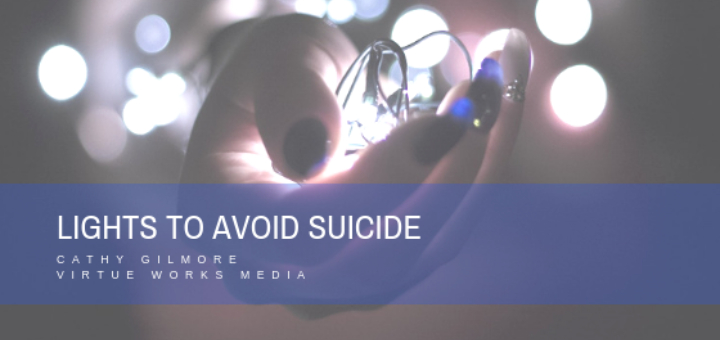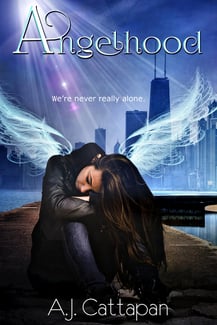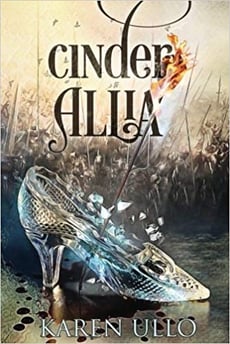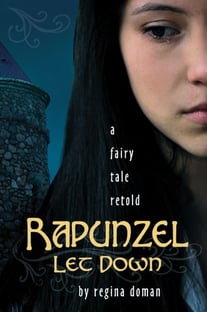
The issue of suicide is a pandemic in our culture. It goes beyond the act of someone taking their own life. If we think about it, our eternal adversary is tempting us to spiritual self-destruction all the time. A more intense two-pronged attack invites abandonment of God in mortal sin, and then the enemy tries to seal the deal inviting the act of physical suicide to make the self-destruction permanent. The evil one specifically targets modern youth to progressively succumb to this snare. Gradually, spiritual apathy can become blindness and paralysis, often followed by an internal spiritual "zombie" state of living death. Young people in such a spiritual condition are prime targets for suicide. And too often they see suicide as a solution to make pain go away.
 Written by A. J. Cattapan, this YA novel is a great choice for readers in high school and older. The author explores the issue of suicide by using an effective storytelling technique. The main character, Nanette, attempts suicide and the entire story unfolds within a literary device portraying her life after death as that of a guardian in a state of "angelhood." In her temporary condition as an angel, this character learns how to help others avoid the trap of suicide. In the tradition of the movie, It's A Wonderful Life and Dicken's classic, A Christmas Carol, this book allows a second look at self-destructive choices, while affirming the tremendous value of each human life. Angelhood is not a work of theology. It does not teach that people become angels in the afterlife. The ending is resolved as a creative re-frame of the story. However, by portraying the main character in a fictional state of angelhood, readers are able to visualize the devastating consequences of suicide. Accompanying Nanette on her journey enables both teens and adults to imagine themselves as guardians; helping friends and family who are vulnerable to suicide to see the value of their own lives.
Written by A. J. Cattapan, this YA novel is a great choice for readers in high school and older. The author explores the issue of suicide by using an effective storytelling technique. The main character, Nanette, attempts suicide and the entire story unfolds within a literary device portraying her life after death as that of a guardian in a state of "angelhood." In her temporary condition as an angel, this character learns how to help others avoid the trap of suicide. In the tradition of the movie, It's A Wonderful Life and Dicken's classic, A Christmas Carol, this book allows a second look at self-destructive choices, while affirming the tremendous value of each human life. Angelhood is not a work of theology. It does not teach that people become angels in the afterlife. The ending is resolved as a creative re-frame of the story. However, by portraying the main character in a fictional state of angelhood, readers are able to visualize the devastating consequences of suicide. Accompanying Nanette on her journey enables both teens and adults to imagine themselves as guardians; helping friends and family who are vulnerable to suicide to see the value of their own lives.
 Author Karen Ullo has re-imagined the Cinderella story in a fabulous way. The Cinderella character is portrayed faithfully. Her honor and humility, along with many other story elements, are reflective of the original fairy tale. In this version, she is a faith-filled Catholic girl living in the Middle Ages who must travel her journey without Prince Charming, who has died before they chance to meet. This freshly retold story unfolds with a new romance, palace intrigue, and adventure. Middle-grade and older readers will enjoy this well-told tale. There's a reason this story is included in an article related to suicide. In Cinder Allia there is a somewhat minor villainous character, a clergyman, who commits suicide. Like Cattapan, this author also uses an effective literary device. Suicide in this story is used to show us the ultimate end of a life of spiritual compromise, treachery and deceit. We see how spiritual self-destruction can lead to physical self-destruction. This small portrayal of suicide is paradoxically life-affirming because it figuratively reminds us that evil choices in life can ensnare us, to make hellish choices in death. Keep in mind, this is a minor character in a story that truly celebrates heroic life and goodness.
Author Karen Ullo has re-imagined the Cinderella story in a fabulous way. The Cinderella character is portrayed faithfully. Her honor and humility, along with many other story elements, are reflective of the original fairy tale. In this version, she is a faith-filled Catholic girl living in the Middle Ages who must travel her journey without Prince Charming, who has died before they chance to meet. This freshly retold story unfolds with a new romance, palace intrigue, and adventure. Middle-grade and older readers will enjoy this well-told tale. There's a reason this story is included in an article related to suicide. In Cinder Allia there is a somewhat minor villainous character, a clergyman, who commits suicide. Like Cattapan, this author also uses an effective literary device. Suicide in this story is used to show us the ultimate end of a life of spiritual compromise, treachery and deceit. We see how spiritual self-destruction can lead to physical self-destruction. This small portrayal of suicide is paradoxically life-affirming because it figuratively reminds us that evil choices in life can ensnare us, to make hellish choices in death. Keep in mind, this is a minor character in a story that truly celebrates heroic life and goodness.
 In this fairy tale retold, author Regina Doman creates a riveting story that truly should be read by every Catholic teen before they graduate from high school. In the context of a love-gone-wrong romance, the author artfully weaves solid Catholic morality regarding sex, life issues, gender identity, honesty, and faith together. This is a book both older teen readers and adults can't put down. The passage on page 403 of the hardcover, in which the male "hero" of the story passionately explains why marriage matters, is worth reading the whole book. Again, it is a small moment in the story that makes it pertinent for this article on suicide. (Warning: spoiler alert) Very late in the story, as the cruel stepmother attempts suicide, it is the male hero (whose life she has tried to destroy) who saves her life. It is a poignant portrayal of mercy, demonstrating that every life, no matter how evil, has the potential for redemption.
In this fairy tale retold, author Regina Doman creates a riveting story that truly should be read by every Catholic teen before they graduate from high school. In the context of a love-gone-wrong romance, the author artfully weaves solid Catholic morality regarding sex, life issues, gender identity, honesty, and faith together. This is a book both older teen readers and adults can't put down. The passage on page 403 of the hardcover, in which the male "hero" of the story passionately explains why marriage matters, is worth reading the whole book. Again, it is a small moment in the story that makes it pertinent for this article on suicide. (Warning: spoiler alert) Very late in the story, as the cruel stepmother attempts suicide, it is the male hero (whose life she has tried to destroy) who saves her life. It is a poignant portrayal of mercy, demonstrating that every life, no matter how evil, has the potential for redemption.
Copyright 2018 Cathy Gilmore
Background image credit: Pexels (2017), CC0 Public Domain. Title added by the author in Canva.
Spiritual Toxins in Entertainment
Into such a climate of spiritual assault comes season 3 of the Netflix series, 13 Reasons Why. This show portrays suicide in a profoundly destructive way. It models for teens how to use suicide as an act of revenge. It invites our youth to do the most self-destructive act with thoroughly evil intentions. In such a state, spiritual death is permanent. It is such an irony that the series season premiers during the month of September: Suicide Prevention Month. Parents share personal experiences of how youth are attempting, and sometimes succeeding, in killing themselves in ways that seem to result from watching this show.Lights in the Dark
Moms and dads urgently need alternatives to put life-saving imagery into the minds of our youth. This article will highlight 3 great YA novels by Catholic authors that each touch on the topic of suicide in a truly life-affirming way. The books are targeted at teens, but can be equally enjoyed and appreciated by grown-ups. We moms and dads need to fill our minds with material that provides an antidote for our sin-saturated culture, and YA books are an easy-reading way to do so.Angelhood
 Written by A. J. Cattapan, this YA novel is a great choice for readers in high school and older. The author explores the issue of suicide by using an effective storytelling technique. The main character, Nanette, attempts suicide and the entire story unfolds within a literary device portraying her life after death as that of a guardian in a state of "angelhood." In her temporary condition as an angel, this character learns how to help others avoid the trap of suicide. In the tradition of the movie, It's A Wonderful Life and Dicken's classic, A Christmas Carol, this book allows a second look at self-destructive choices, while affirming the tremendous value of each human life. Angelhood is not a work of theology. It does not teach that people become angels in the afterlife. The ending is resolved as a creative re-frame of the story. However, by portraying the main character in a fictional state of angelhood, readers are able to visualize the devastating consequences of suicide. Accompanying Nanette on her journey enables both teens and adults to imagine themselves as guardians; helping friends and family who are vulnerable to suicide to see the value of their own lives.
Written by A. J. Cattapan, this YA novel is a great choice for readers in high school and older. The author explores the issue of suicide by using an effective storytelling technique. The main character, Nanette, attempts suicide and the entire story unfolds within a literary device portraying her life after death as that of a guardian in a state of "angelhood." In her temporary condition as an angel, this character learns how to help others avoid the trap of suicide. In the tradition of the movie, It's A Wonderful Life and Dicken's classic, A Christmas Carol, this book allows a second look at self-destructive choices, while affirming the tremendous value of each human life. Angelhood is not a work of theology. It does not teach that people become angels in the afterlife. The ending is resolved as a creative re-frame of the story. However, by portraying the main character in a fictional state of angelhood, readers are able to visualize the devastating consequences of suicide. Accompanying Nanette on her journey enables both teens and adults to imagine themselves as guardians; helping friends and family who are vulnerable to suicide to see the value of their own lives.
Cinder Allia
 Author Karen Ullo has re-imagined the Cinderella story in a fabulous way. The Cinderella character is portrayed faithfully. Her honor and humility, along with many other story elements, are reflective of the original fairy tale. In this version, she is a faith-filled Catholic girl living in the Middle Ages who must travel her journey without Prince Charming, who has died before they chance to meet. This freshly retold story unfolds with a new romance, palace intrigue, and adventure. Middle-grade and older readers will enjoy this well-told tale. There's a reason this story is included in an article related to suicide. In Cinder Allia there is a somewhat minor villainous character, a clergyman, who commits suicide. Like Cattapan, this author also uses an effective literary device. Suicide in this story is used to show us the ultimate end of a life of spiritual compromise, treachery and deceit. We see how spiritual self-destruction can lead to physical self-destruction. This small portrayal of suicide is paradoxically life-affirming because it figuratively reminds us that evil choices in life can ensnare us, to make hellish choices in death. Keep in mind, this is a minor character in a story that truly celebrates heroic life and goodness.
Author Karen Ullo has re-imagined the Cinderella story in a fabulous way. The Cinderella character is portrayed faithfully. Her honor and humility, along with many other story elements, are reflective of the original fairy tale. In this version, she is a faith-filled Catholic girl living in the Middle Ages who must travel her journey without Prince Charming, who has died before they chance to meet. This freshly retold story unfolds with a new romance, palace intrigue, and adventure. Middle-grade and older readers will enjoy this well-told tale. There's a reason this story is included in an article related to suicide. In Cinder Allia there is a somewhat minor villainous character, a clergyman, who commits suicide. Like Cattapan, this author also uses an effective literary device. Suicide in this story is used to show us the ultimate end of a life of spiritual compromise, treachery and deceit. We see how spiritual self-destruction can lead to physical self-destruction. This small portrayal of suicide is paradoxically life-affirming because it figuratively reminds us that evil choices in life can ensnare us, to make hellish choices in death. Keep in mind, this is a minor character in a story that truly celebrates heroic life and goodness.
Rapunzel Let Down
 In this fairy tale retold, author Regina Doman creates a riveting story that truly should be read by every Catholic teen before they graduate from high school. In the context of a love-gone-wrong romance, the author artfully weaves solid Catholic morality regarding sex, life issues, gender identity, honesty, and faith together. This is a book both older teen readers and adults can't put down. The passage on page 403 of the hardcover, in which the male "hero" of the story passionately explains why marriage matters, is worth reading the whole book. Again, it is a small moment in the story that makes it pertinent for this article on suicide. (Warning: spoiler alert) Very late in the story, as the cruel stepmother attempts suicide, it is the male hero (whose life she has tried to destroy) who saves her life. It is a poignant portrayal of mercy, demonstrating that every life, no matter how evil, has the potential for redemption.
In this fairy tale retold, author Regina Doman creates a riveting story that truly should be read by every Catholic teen before they graduate from high school. In the context of a love-gone-wrong romance, the author artfully weaves solid Catholic morality regarding sex, life issues, gender identity, honesty, and faith together. This is a book both older teen readers and adults can't put down. The passage on page 403 of the hardcover, in which the male "hero" of the story passionately explains why marriage matters, is worth reading the whole book. Again, it is a small moment in the story that makes it pertinent for this article on suicide. (Warning: spoiler alert) Very late in the story, as the cruel stepmother attempts suicide, it is the male hero (whose life she has tried to destroy) who saves her life. It is a poignant portrayal of mercy, demonstrating that every life, no matter how evil, has the potential for redemption.
Internalizing Light
Each of these stories invites us to imagine and reflect on the issue of suicide in ways that help us to see it for the true dead end that it is. As our culture drifts further into a place where suicide is seen as merciful way to end or avoid suffering, it is tremendously important to imagine the eternal value of every life. A life full of pain, or even full of sinfulness, is still precious to God. Because God is in the business of making all things new. It's our job not to rob Him of the opportunity of redeeming our suffering, and our sin. He needs us to be heroes to try our best to save the lives of people tempted by self-destruction in any way, including suicide.Copyright 2018 Cathy Gilmore
Background image credit: Pexels (2017), CC0 Public Domain. Title added by the author in Canva.
About the Author
Cathy Gilmore
Cathy Gilmore is an award-winning author, educator, and founder of the Virtue Literacy Project, an innovative approach to family virtue formation. Follow Cathy on Twitter @PowerofParable.


.png?width=1806&height=731&name=CatholicMom_hcfm_logo1_pos_871c_2728c%20(002).png)
Comments